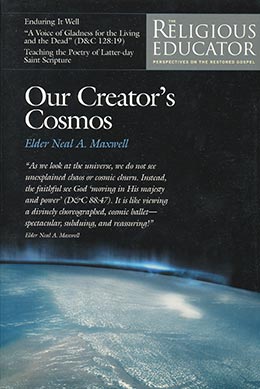“Her Stakes Must Be Strengthened” (D&C 82:14): The Symbolism of Isaiah’s Tent
Richard W. Hall
Richard W. Hall, “‘Her Stakes Must Be Strengthened’ (D&C 82:14): The Symbolism of Isaiah’s Tent,” Religious Educator3, no. 2 (2002): 67–75.
Richard W. Hall was an institute instructor of the Tucson Arizona Institute of Religion when this was published.
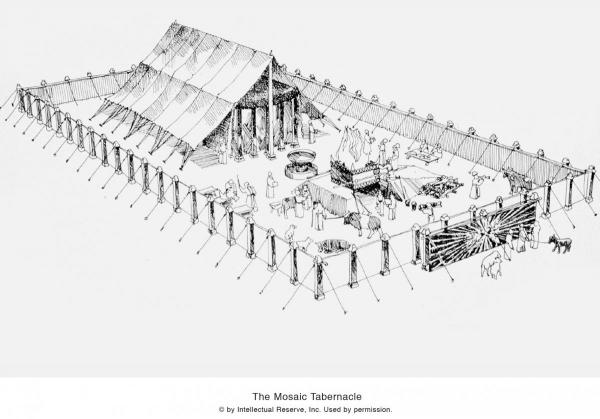
Members of The Church of Jesus Christ of Latter-day Saints quite commonly find themselves clarifying an invitation to friends unfamiliar with Church terms about an activity at the stake center. The invitation can be especially interesting when the activity is a fireside at the stake center. Friends may hear the steak part and begin to imagine a tasty meal but are unfamiliar with the restaurant mentioned. The image in their minds drives their understanding of the conversation.
The Prophet Joseph Smith said the following during the April 1844 general conference: “I have received instructions from the Lord that from henceforth wherever Elders of Israel shall build up churches and branches unto the Lord throughout the States, there shall be a stake of Zion. In the great cities, as Boston, New York, &c., there shall be stakes. It is a glorious proclamation, and I reserved it to the last, and designed it to be understood that this work shall commence after the washings, anointings and endowments have been performed here.”[1]
These instructions, given near the end of Joseph’s mortal ministry, have certainly been fulfilled. We gauge the growth of the Church in any region by the establishment of stakes. Members of the Church throughout the world know what a stake is; however, is the image in their minds the same as the figure intended by the prophet who originated the symbol?
I had a pair of experiences a few years ago that caused me to reflect on the mental representation of members of the Church engendered by the phrase “the stakes of Zion.” In the spring of 1996, I was serving on the religion faculty of the Jerusalem Center for Near Eastern Studies. During that intense experience in the land of the scriptures, I focused my attention on biblical images. I liked looking around for examples of those images in the culture and the geography. Early one day on my morning walk, I noticed that some poles had been erected on a vacant parcel of the center’s property. During some free time later in the morning, I went up the hill to see what was being built. Mr. Hani, the center’s handyman, was erecting the large Bedouin tent that had been purchased in Beersheba. To satisfy my curiosity, I volunteered to be the assistant Bedouin tent erector; however, I was of marginal help because I kept asking questions about the various parts of the tent, and I kept stopping to take pictures. I experienced a memorable day in which my mind was filled with the sights, dimensions, and textures of a Bedouin tent. The next week the students partook of a Bedouin meal in that tent, which added tastes and aromas to my mental picture.
A year and a half later, I was serving as a Sunday School teacher in my ward in Tucson, Arizona. At the time, we were studying the Old Testament. While preparing for an upcoming lesson, I read the “Attention Activity” section in the lesson manual. It suggested that I draw a picture of a tent and display a tent stake. The section provided a sample drawing of a simple camping tent familiar to western members of the Church. As I looked at what we in the West call a tent stake, I thought, “The only tool that will do the job when you want to strengthen this kind of a stake is a hammer.” I then imagined the President of the Quorum of the Twelve sending his fellow Apostles out to strengthen the stakes with their hammers. Strengthening the stakes of the Church by beating them further into the ground was a brutal image. I could see then that the tent from which this image was borrowed was not a fancy Western springbar camping tent but rather a simple Bedouin tent.
Tent Imagery in Isaiah
The originator of this symbol was the prophet Isaiah. His world included the Rechabites, a tent-dwelling people who descended from Jethro (see Jeremiah 35:5–9). Much like the Bedouin tribes who live in regions of the Near East today, they did not own land but probably wandered as migrant laborers. Their tents would have been a common image to the people Isaiah was teaching. As he spoke of the millennial day, he said, “Look upon Zion, the city of our solemnities: thine eyes shall see Jerusalem a quiet habitation, a tabernacle [tent] that shall not be taken down; not one of the stakes thereof shall ever be removed, neither shall any of the cords thereof be broken” (Isaiah 33:20). He also used the image to teach about the gathering in these words: “Enlarge the place of thy tent, and let them stretch forth the curtains of thy habitations: spare not, lengthen thy cords and strengthen thy stakes” (Isaiah 54:2).
This tent imagery is not found anywhere else in the Old Testament, nor is it found in the New Testament. It is found in an Isaiah quote in the Book of Mormon (see 3 Nephi 22:2), and Moroni may have borrowed the image to close the record (see Moroni 10:31).The figure is used extensively by the Lord, however, as He spoke to the Church through the Prophet Joseph Smith, using the imagery in ten of the revelations in the Doctrine and Covenants. It is an ancient figure with latter-day implications.
The image of a Bedouin tent with its component parts and functions is clearly delineated by Isaiah. But what did he intend it to mean? What did he see that was like a tent in his vision of the future? Joseph Smith commented on the importance of being careful as we try to understand scriptural symbols. In January 1843 he taught, “What is the rule of interpretation? Just no interpretation at all. Understand it precisely as it reads. I have a key by which I understand the scriptures. I enquire, what was the question which drew out the answer, or caused Jesus to utter the parable?”[2] Just what questions was Isaiah answering when he basically said, “It’s like that tent over there”?
In Isaiah 3 and 4, Isaiah prophesied of two contrasting conditions that will attend the Lord’s coming: the destruction of the wicked and the blessing of the righteous. This same contrast was described in a later chapter in very graphic terms and brought forth a question: “The people shall be as the burnings of lime: as thorns cut up shall they be burned in the fire. . . . The sinners in Zion are afraid; fearfulness hath surprised the hypocrites. Who among us shall dwell with the devouring fire? who among us shall dwell with everlasting burnings?” (Isaiah 33:12, 14). Might I suggest that the general question he tried to then answer can be phrased like this: How will the Lord protect the righteous from the devastation that will attend His coming in the latter days? Isaiah assured the hopeful that they will be protected in a tent, adding that this tent “shall not be taken down; not one of the stakes thereof shall ever be removed, neither shall any of the cords thereof be broken” (Isaiah 33:20).
In chapter 54, Isaiah dealt with another condition in the latter days. The Lord will prepare for His coming by gathering scattered Israel. The Lord declared to Isaiah, “More are the children of the desolate than the children of the married wife” (Isaiah 54:1). Question: How will the Lord fit the gathered house of Israel into His protective tent? Answer: “Enlarge the place of thy tent, and let them stretch forth the curtains of thine habitations: spare not, lengthen thy cords, and strengthen thy stakes” (Isaiah 54:2). He had already established the figure of a sturdy latter-day tent. The reasonable solution to the population problem would be to expand the tent.
When Isaiah looked to a tent as a type of the Lord’s protection in the last days, what did he see? He probably saw a very functional shelter similar to the Bedouin tent of the Near East. Such a tent uses a minimum of wood, which was and is a precious commodity in that arid land. Its sides can be rolled up during the summer to allow cooling breezes to pass through the shade provided by its roof. It matches Isaiah’s description of a tent that would provide “a shadow in the daytime from the heat” (Isaiah 4:6). The fabric covering of the tent is woven of goat hair. Incidentally, one of the layers of covering for the Tabernacle of Moses was also made of goat’s hair (see Exodus 26:7). A useful feature of goat hair is that it swells when wet, which closes the holes of the loose weave and creates a surface that repels the rain and thus provides “a covert from storm and from rain” (Isaiah 4:6). I have observed this feature firsthand. Between the time I helped Mr. Hani put up the tent and the Bedouin dinner for the students, we had several days of rain. When I checked the status of the tent, I found that the floor of the tent was dry, whereas the ground outside was saturated. However, I will mention that the aroma of wet goat hair is less than inviting.
Another important feature of a Bedouin tent is its expandability. If our families have grown or we have company coming for an extended period, this tent can grow. Isaiah described the process when he said, “Lengthen thy cords, and strengthen thy stakes” (Isaiah 54:2).
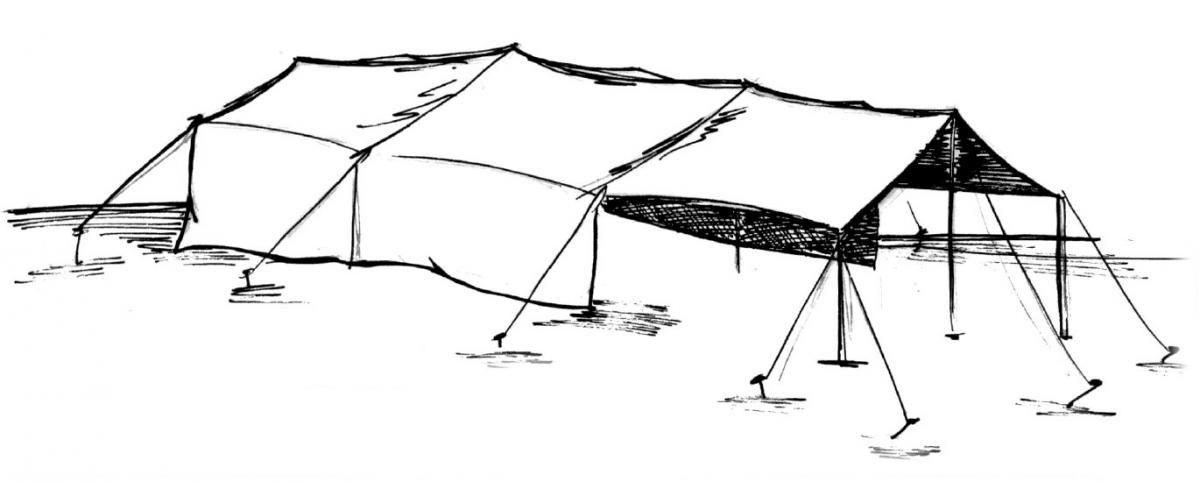
The potential for expansion of such a tent is limited primarily by land and materials. In the Near East today, Bedouin tents can be found that stretch a hundred feet or longer. Expandability is not an important feature of a western camping tent. When we need more room, we get another tent. We do not lengthen cords or strengthen stakes.
Pieces of the Figure
The tent that served as Isaiah’s symbol of the Lord’s protection in the latter days included a parts list of nails, stakes, cords, and curtains. Since Isaiah cites these parts as he draws his comparisons, it is important that they be a part of our mental image as well.
The nails were not mentioned by Isaiah as he invoked the tent imagery, but they were an important part of the tent. The story of Jael, the wife of Heber the Kenite, illustrates the nature of a tent nail. The tent-dwelling Rechabites were a tribe of the Kenites. When the Canaanite general Sisera sought refuge in the tent of Jael, she “took an hammer in her hand, and went softly unto him, and smote the nail into his temples, and fastened it into the ground” (Judges 4:21). The tent nails were driven into the ground, and cords were attached to them to hold the tent in place. (Fastening someone’s head to the ground was an unusual use for them.) They are equivalent to the stakes of a western camping tent.
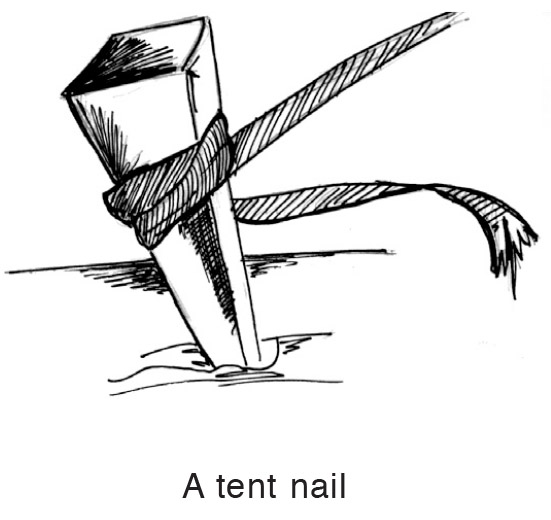
I have found it more clarifying to think of the stake of Isaiah’s tent as a tent pole. An important fact to remember is that Isaiah’s teaching image was of the entire tent and was not limited to any one of its component parts. When Isaiah spoke of the sturdiness of God’s protection, he indicated that none of the stakes would be removed. Enlarging the tent included the need to strengthen the stakes. The stakes in the tent I helped Mr. Hani erect were a sorry lot; they were fine examples of wood that had been scrounged. A couple of the stakes had additional boards wired to them to give them extra strength. However, that is not the image of Isaiah’s call to strengthen the stakes. Isaiah had surely seen a tent-dwelling family add room to its dwelling by positioning additional stakes at one end of the tent. He was familiar not only with the structure of the tent but also with the process by which it could be enlarged.
The tent cords were the ropes that connected the nails and the stakes and provided the structural framework of the tent or tabernacle. Actually, the phrase “lengthen thy cords, and strengthen thy stakes” (Isaiah 54:2) is a description by which the entire tent was made strong enough to withstand the storms. One strengthens the stakes by means of the cords.
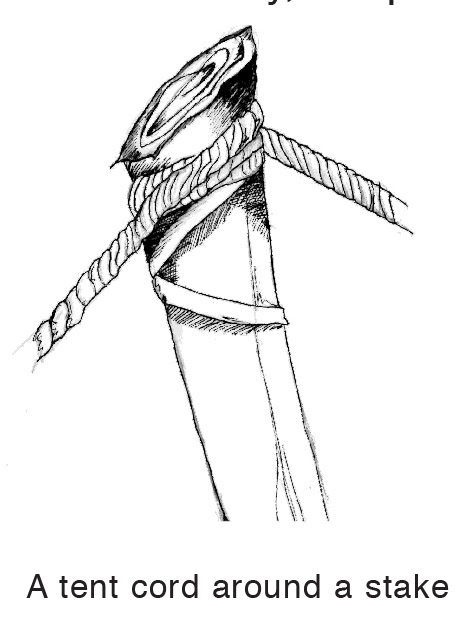
In the figure at left, imagine the length of cord on the right running back to a tent stake that was already a part of the tent.[3] The cord on the left is attached to a tent nail, which is fastened into the ground. These connections were the means by which a strong framework was created for the tent.
Onto this framework were fastened the curtains of the tent. This covering provided the walls and roof of the dwelling. Most commonly they were made of goat hair; however, the Lord instructed Moses to “make the tabernacle with ten curtains of fine twined linen, and blue, and purple, and scarlet: with cherubims of cunning work shalt thou make them” (Exodus 26:1; emphasis added). So a tent could be both functional and beautiful.
Each part of the tent was important. The nails kept it fastened in place. The stakes were the means of support. The cords connected the nails to the stakes and the stakes to each other. These connections tied the frame of the tent into one sturdy whole. The curtains provided shade in the day and protection from storms. Isaiah saw in this simple structure a symbol for explaining God’s latter-day work.
Insights from the Imagery
Nephi delighted in the words of Isaiah because “he verily saw [Nephi’s] Redeemer” (2 Nephi 11:2). I have come to value Isaiah because he saw our day and explained what he saw in a manner that we may see as well. The Lord borrowed a word from Isaiah to name an important feature of His latter-day Church. When He chose stake as the name of the unit of the Church that provides our local direction, He also chose the symbol of the ancient tent.
Consider the sources of strength for a newly established stake in the Church. Like a tent cord leading from a standing tent, much strength flows from the body of the Church in the form of finances coming from surpluses of established stakes. Missionaries from the stronger stakes also provide assistance. Training and other resources flow along this line, giving additional support. The cord leading to the nail in the ground represents the strength and firmly rooted faith a stake receives from its local members. When the new stake becomes strong enough, it then yields support to another stake that will be planted nearby.
When we come to recognize the insight that this tent imagery lends to our understanding, we are impressed with the seership of the prophet Isaiah. He surely saw our day, as did the Book of Mormon prophets. He saw the growth of Zion in the latter days with such clarity that he was able to borrow an image from his culture to describe it.
Application to the Doctrine and Covenants
When our friends begin to hear stake rather than steak, this new insight helps to guide their understanding of the Church. Note the following scripture chain from the Doctrine and Covenants. Look at what the Lord said to His Church through the lens of your expanded sense of tent imagery. By examining some simple insights, we may begin to use tent imagery to derive additional connections.
Doctrine and Covenants 82:14. For Zion must increase in beauty, and in holiness; her borders must be enlarged; her stakes must be strengthened; yea, verily I say unto you, Zion must arise and put on her beautiful garments.
Zion is to increase in size, beauty, and holiness. Think upon that challenge as if we spoke of a tent. Stakes must be added, but this is not to be a common tent. The curtains must be more beautiful. The activities within this tent are not to be common or profane. A larger, more beautiful, and holier tent sounds like a description of the ancient tabernacle. Reflect upon the words of President Howard W. Hunter, who invited the Church to “look to the temple of the Lord as the great symbol of your membership.”[4]
Why the call for beauty? Perhaps Zion will need to expand because its beauty will serve as an attraction to those it seeks to gather. Similarly, the call for increased holiness may be to ensure the Lord’s protecting hand upon the Church. Just as each component in a tent interacts with the other components to accomplish its purposes, perhaps the growth, beauty, and holiness of Zion interact to fulfill its destiny.
Doctrine and Covenants 133:8–9. Send forth the elders of my church unto the nations which are afar off; unto the islands of the sea; send forth unto foreign lands; call upon all nations, first upon the Gentiles, and then upon the Jews. And behold, and lo, this shall be their cry, and the voice of the Lord unto all people: Go ye forth unto the land of Zion, that the borders of my people may be enlarged, and that her stakes may be strengthened, and that Zion may go forth unto the regions round about.
Notice the role that proclaiming the gospel plays. It is the process by which Israel is gathered. It is concurrent with the process of building up the Church (Zion) and strengthening her stakes. The rate of gathering has increased as Zion has put on her beautiful garments.
Doctrine and Covenants 109:39. And whatsoever city thy servants shall enter, and the people of that city receive their testimony, let thy peace and thy salvation be upon that city; that they may gather out of that city the righteous, that they may come forth to Zion, or to her stakes, the places of thine appointment, with songs of everlasting joy.
Who is supervising the expansion of Zion? The Lord directs, through the Prophet, where each new stake to the tent of Zion is placed. The Lord is the quartermaster.
Doctrine and Covenants 109:59. We ask thee to appoint unto Zion other stakes besides this one which thou hast appointed, that the gathering of thy people may roll on in great power and majesty, that thy work may be cut short in righteousness.
The addition of stakes to the tent of Zion is a growth indicator. Such growth is the result of blessings from God.
Doctrine and Covenants 101:21–22. Until the day cometh when there is found no more room for them; and then I have other places which I will appoint unto them, and they shall be called stakes, for the curtains or the strength of Zion. Behold, it is my will, that all they who call on my name, and worship me according to mine everlasting gospel, should gather together, and stand in holy places.
The framework of stakes, cords, and nails in a tent provides the support for the curtains. The Lord defines those curtains as the strength of Zion. Remember that in a tent it is the curtains, when properly supported, that provide the protection from heat and storms. One source of strength to the Church is the obedience of the members. They can obey the call to gather, the command to pray, and the principles and ordinances of the gospel. This obedience establishes the holy place that Zion is commanded to become.
Doctrine and Covenants 115:6. And that the gathering together upon the land of Zion, and upon her stakes, may be for a defense, and for a refuge from the storm, and from wrath when it shall be poured out without mixture upon the whole earth.
Like a Bedouin tent, the tent of Zion is for a defense and a refuge. The timing of its establishment and growth is providential because of the impending storm.
Doctrine and Covenants 45:32. But my disciples shall stand in holy places, and shall not be moved; but among the wicked, men shall lift up their voices and curse God and die.
The latter-day storm is going to be so violent and dreadful that the only safe place to be will be in the tent of Zion. We will be wise to stay in the tent.
Powerful Imagery
Church members delight in the teachings of their leaders. We trust that the teachings they share with us have come into their minds by means of revelation from God. We share this confidence with the many faithful Saints who have hearkened to living prophets through the ages. Communicating the mind and will of the Lord to us is a significant portion of a prophet’s burden.
Many prophets, both ancient and modern, have used comparisons to help the Saints understand the Lord’s messages. Recent leaders have employed objects such as crocodiles, keyboards, and the deck of the Titanic. Our familiarity with these objects increases our ability to understand the intended lessons.
The writings of the prophet Isaiah are rich in comparisons. Because our worlds differ, we are often challenged to find understanding in the figures he used. We are commanded to study the words of Isaiah because there is profit in seeking to better understand his images.
Notes
[1] Joseph Smith, Teachings of the Prophet Joseph Smith, comp. Joseph Fielding Smith (Salt Lake City: Deseret Book, 1976), 363.
[2] Joseph Smith, History of the Church of Jesus Christ of Latter-day Saints, ed. B.H. Roberts, 2d ed., rev. (Salt Lake City: Deseret Book, 1978), 5:261.
[3] The figures in this article were drawn by Shannon Gillman. Shannon is an architectural student at the University of Arizona. She is also a student at the Tucson Arizona Institute of Religion.
[4] Howard W. Hunter, in Conference Report, October 1994, 8; or Ensign, November 1994, 8.
